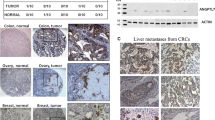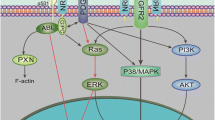Abstract
Angiopoietin4(ANGPT4) which plays a significant role in endothelial cell proliferation, survival, angiogenesis and expansion in tumors and other pathological states is a significant regulator of tumor angiogenesis. ANGPT4 expression is enhanced in many cancer cells. For example, the overexpression of ANGPT4 promotes the formation, development and progress of lung adenocarcinoma, glioblastoma and ovarian cancer. Related studies show that ANGPT4 encourages the proliferation, survival and invasion of tumor cells, while promoting the expansion of the tumor vascular system and affecting the tumor immune microenvironment. ANGPT4 can also promote carcinogenesis by affecting the ERK1/2, PI3K/AKT and other signal pathways downstream of tyrosine kinase with immunoglobulin-like and EGF-like domains 2(TIE2) and TIE2. Therefore, ANGPT4 may be a potential and significant biomarker for predicting malignant tumor progression and adverse outcomes. In addition, inhibition of ANGPT4 may be a meaningful cancer treatment. This paper reviews the latest research results of ANGPT4 in preclinical research, and emphasizes its role in carcinogenesis. Additional research on the carcinogenic function of ANGPT4 could provide new insights into cancer biology and novel methods for cancer diagnosis and treatment.


Similar content being viewed by others
Change history
06 April 2024
This article has been retracted. Please see the Retraction Notice for more detail: https://doi.org/10.1007/s10238-024-01338-8
References
He FF, Zhang D, Chen Q, et al. Angiopoietin-Tie signaling in kidney diseases: an updated review. FEBS Lett. 2019;593:2706–15.
Fagiani E, Christofori G. Angiopoietins in angiogenesis. Cancer Lett. 2013;328:18–26.
Valenzuela DM, Griffiths JA, Rojas J, et al. Angiopoietins 3 and 4: diverging gene counterparts in mice and humans. Proc Natl Acad Sci U S A. 1999;96:1904–9.
Tsakogiannis D, Nikolakopoulou A, Zagouri F, et al. Update overview of the role of angiopoietins in lung cancer. Medicina (Kaunas). 2021;57:1191.
Wu Q, Xu WD, Huang AF. Role of angiopoietin-2 in inflammatory autoimmune diseases: a comprehensive review. Int Immunopharmacol. 2020;80: 106223.
Yang H, Zhang M, Mao XY, Chang H, Perez-Losada J, Mao JH. Distinct clinical impact and biological function of angiopoietin and angiopoietin-like proteins in human breast cancer. Cells. 2021;10:2590.
Elamaa H, Kihlström M, Kapiainen E, et al. Angiopoietin-4-dependent venous maturation and fluid drainage in the peripheral retina. Elife. 2018. https://doi.org/10.7554/eLife.37776.
Hu B, Cheng SY. Angiopoietin-2: development of inhibitors for cancer therapy. Curr Oncol Rep. 2009;11:111–6.
Thomas M, Augustin HG. The role of the angiopoietins in vascular morphogenesis. Angiogenesis. 2009;12:125–37.
Beaudet MJ, Rueda N, Kobinger GP, Villeneuve J, Vallières L. Construction of a ganciclovir-sensitive lentiviral vector to assess the influence of angiopoietin-3 and soluble Tie2 on glioma growth. J Neurooncol. 2010;99:1–11.
Zhang S, Chen Z, Yang J, et al. Angiopoietin-3 overexpression in tobacco smoke-induced mouse lung tumors and its relation to vitamin E intervention. Mol Med Rep. 2008;1:729–33.
Xu Y, Liu YJ, Yu Q. Angiopoietin-3 inhibits pulmonary metastasis by inhibiting tumor angiogenesis. Cancer Res. 2004;64:6119–26.
Cong Z, Diao Y, Li X, et al. Long non-coding RNA linc00665 interacts with YB-1 and promotes angiogenesis in lung adenocarcinoma. Biochem Biophys Res Commun. 2020;527:545–52.
Brown LF, Dezube BJ, Tognazzi K, Dvorak HF, Yancopoulos GD. Expression of Tie1, Tie2, and angiopoietins 1, 2, and 4 in Kaposi’s sarcoma and cutaneous angiosarcoma. Am J Pathol. 2000;156:2179–83.
Brunckhorst MK, Xu Y, Lu R, Yu Q. Angiopoietins promote ovarian cancer progression by establishing a procancer microenvironment. Am J Pathol. 2014;184:2285–96.
Brunckhorst MK, Wang H, Lu R, Yu Q. Angiopoietin-4 promotes glioblastoma progression by enhancing tumor cell viability and angiogenesis. Cancer Res. 2010;70:7283–93.
Ren Q, Chan KW, Huang H, et al. Platelet-derived alpha-granules are associated with inflammation in patients with NK/T-cell lymphoma-associated hemophagocytic syndrome. Cytokine. 2020;126: 154878.
Matas-Céspedes A, Rodriguez V, Kalko SG, et al. Disruption of follicular dendritic cells-follicular lymphoma cross-talk by the pan-PI3K inhibitor BKM120 (Buparlisib). Clin Cancer Res. 2014;20:3458–71.
Gupta N, Park JE, Tse W, et al. ERO1α promotes hypoxic tumor progression and is associated with poor prognosis in pancreatic cancer. Oncotarget. 2019;10:5970–82.
Yamakawa M, Liu LX, Belanger AJ, et al. Expression of angiopoietins in renal epithelial and clear cell carcinoma cells: regulation by hypoxia and participation in angiogenesis. Am J Physiol Renal Physiol. 2004;287:F649–57.
Shaw A, Gipp J, Bushman W. The Sonic Hedgehog pathway stimulates prostate tumor growth by paracrine signaling and recapitulates embryonic gene expression in tumor myofibroblasts. Oncogene. 2009;28:4480–90.
Nakayama T, Hatachi G, Wen CY, et al. Expression and significance of Tie-1 and Tie-2 receptors, and angiopoietins-1, 2 and 4 in colorectal adenocarcinoma: immunohistochemical analysis and correlation with clinicopathological factors. World J Gastroenterol. 2005;11:964–9.
Nakayama T, Yoshizaki A, Kawahara N, et al. Expression of Tie-1 and 2 receptors, and angiopoietin-1, 2 and 4 in gastric carcinoma; immunohistochemical analyses and correlation with clinicopathological factors. Histopathology. 2004;44:232–9.
Nakayama T, Inaba M, Naito S, et al. Expression of angiopoietin-1, 2 and 4 and Tie-1 and 2 in gastrointestinal stromal tumor, leiomyoma and schwannoma. World J Gastroenterol. 2007;13:4473–9.
Kesler CT, Pereira ER, Cui CH, et al. Angiopoietin-4 increases permeability of blood vessels and promotes lymphatic dilation. Faseb j. 2015;29:3668–77.
Grosios K, Leek JP, Markham AF, Yancopoulos GD, Jones PF. Assignment of ANGPT4, ANGPT1, and ANGPT2 encoding angiopoietins 4, 1 and 2 to human chromosome bands 20p13, 8q22.3–>q23 and 8p23.1, respectively, by in situ hybridization and radiation hybrid mapping. Cytogenet Cell Genet. 1999;84:118–20.
Lee HJ, Cho CH, Hwang SJ, et al. Biological characterization of angiopoietin-3 and angiopoietin-4. Faseb j. 2004;18:1200–8.
Holash J, Maisonpierre PC, Compton D, et al. Vessel cooption, regression, and growth in tumors mediated by angiopoietins and VEGF. Science. 1999;284:1994–8.
Huang H, Lai JY, Do J, et al. Specifically targeting angiopoietin-2 inhibits angiogenesis, Tie2-expressing monocyte infiltration, and tumor growth. Clin Cancer Res. 2011;17:1001–11.
Ilhan-Mutlu A, Siehs C, Berghoff AS, et al. Expression profiling of angiogenesis-related genes in brain metastases of lung cancer and melanoma. Tumour Biol. 2016;37:1173–82.
Han MA, Jeon JH, Shin JY, et al. Intramyocardial delivery of human cardiac stem cell spheroids with enhanced cell engraftment ability and cardiomyogenic potential for myocardial infarct repair. J Control Release. 2021;336:499–509.
Petrova TV, Koh GY. Organ-specific lymphatic vasculature: from development to pathophysiology. J Exp Med. 2018;215:35–49.
Tammela T, Alitalo K. Lymphangiogenesis: molecular mechanisms and future promise. Cell. 2010;140:460–76.
Tammela T, Saaristo A, Lohela M, et al. Angiopoietin-1 promotes lymphatic sprouting and hyperplasia. Blood. 2005;105:4642–8.
Gale NW, Thurston G, Hackett SF, et al. Angiopoietin-2 is required for postnatal angiogenesis and lymphatic patterning, and only the latter role is rescued by Angiopoietin-1. Dev Cell. 2002;3:411–23.
Olsen MW, Ley CD, Junker N, Hansen AJ, Lund EL, Kristjansen PE. Angiopoietin-4 inhibits angiogenesis and reduces interstitial fluid pressure. Neoplasia. 2006;8:364–72.
Kim KE, Cho CH, Kim HZ, Baluk P, McDonald DM, Koh GY. In vivo actions of angiopoietins on quiescent and remodeling blood and lymphatic vessels in mouse airways and skin. Arterioscler Thromb Vasc Biol. 2007;27:564–70.
Kapiainen E, Kihlström MK, Pietilä R, et al. The amino-terminal oligomerization domain of angiopoietin-2 affects vascular remodeling, mammary gland tumor growth, and lung metastasis in mice. Cancer Res. 2021;81:129–43.
Hudlikar RR, Chou PJ, Kuo HD, Sargsyan D, Wu R, Kong AN. Long term exposure of cigarette smoke condensate (CSC) mediates transcriptomic changes in normal human lung epithelial Beas-2b cells and protection by garlic compounds. Food Chem Toxicol. 2023;174: 113656.
Tim CR, Bossini PS, Kido HW, et al. Effects of low level laser therapy on inflammatory and angiogenic gene expression during the process of bone healing: a microarray analysis. J Photochem Photobiol B. 2016;154:8–15.
Duran CL, Borriello L, Karagiannis GS, Entenberg D, Oktay MH, Condeelis JS. Targeting Tie2 in the tumor microenvironment: from angiogenesis to dissemination. Cancers (Basel). 2021;13:5730.
Wu Z, Shi Y, Cui Y, et al. Single-cell analysis reveals an Angpt4-initiated EPDC-EC-CM cellular coordination cascade during heart regeneration. Protein Cell. 2023;14:350–68.
Chen X, Fu W, Tung CE, Ward NL. Angiopoietin-1 induces neurite outgrowth of PC12 cells in a Tie2-independent, beta1-integrin-dependent manner. Neurosci Res. 2009;64:348–54.
Dallabrida SM, Ismail NS, Pravda EA, et al. Integrin binding angiopoietin-1 monomers reduce cardiac hypertrophy. Faseb j. 2008;22:3010–23.
Imanishi Y, Hu B, Jarzynka MJ, et al. Angiopoietin-2 stimulates breast cancer metastasis through the alpha(5)beta(1) integrin-mediated pathway. Cancer Res. 2007;67:4254–63.
Yamakawa M, Liu LX, Date T, et al. Hypoxia-inducible factor-1 mediates activation of cultured vascular endothelial cells by inducing multiple angiogenic factors. Circ Res. 2003;93:664–73.
Turan N, Ghalwash MF, Katari S, Coutifaris C, Obradovic Z, Sapienza C. DNA methylation differences at growth related genes correlate with birth weight: a molecular signature linked to developmental origins of adult disease? BMC Med Genomics. 2012;5:10.
Funding
The present study was supported by the Natural Science Foundation of HuNan Province (2021JJ50070 and 2023JJ41066) and the Key Project of Scientific Research Project of HuNan Provincial Education Department (22A0317).
Author information
Authors and Affiliations
Contributions
All authors contributed to the study conception and design. WCZ, JLC and QFZ designed the project. WCZ, JLC and JPG wrote the paper. YKL drawing the graph. YKL and JZ revised the manuscript, designed the experiment.
Corresponding authors
Ethics declarations
Conflict of interest
The authors have no relevant financial or non-financial interests to disclose.
Additional information
Publisher's Note
Springer Nature remains neutral with regard to jurisdictional claims in published maps and institutional affiliations.
This article has been retracted. Please see the retraction notice for more detail: https://doi.org/10.1007/s10238-024-01338-8
Rights and permissions
Springer Nature or its licensor (e.g. a society or other partner) holds exclusive rights to this article under a publishing agreement with the author(s) or other rightsholder(s); author self-archiving of the accepted manuscript version of this article is solely governed by the terms of such publishing agreement and applicable law.
About this article
Cite this article
Zhou, Wc., Zhang, Qf., Chen, Jl. et al. RETRACTED ARTICLE: Angiopoietin4 (ANGPT4) expression and potential mechanisms in carcinogenesis: current achievements and perspectives. Clin Exp Med 23, 4449–4456 (2023). https://doi.org/10.1007/s10238-023-01178-y
Received:
Accepted:
Published:
Issue Date:
DOI: https://doi.org/10.1007/s10238-023-01178-y




